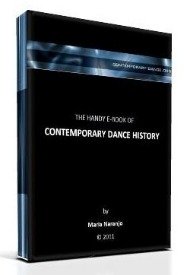How to analyze a choreographic piece?
by Moises
(Mexico)
Hello Maria,
I am a student of a contemporary dance’s degree in Mazatlán, Sinalóa. I just started to work on my graduating project’s draft and I need to find theoretical grounds to structure a formal analysis of a choreographic piece. I haven’t found a text that can help me. I imagine you might know in which direction I should go to get close to my purpose.
Thanks a lot for your attention.
Greetings from Mexico!!
Moises
Comments for How to analyze a choreographic piece?
|
||
|
||
The handy e-book of CONTEMPORARY DANCE HISTORY:
The Dance Thinker is our occasional E-zine. Fill in the form below to receive it for free and join us.
Read:
"The Dance Thinker"
BACK ISSUES
Post contemporary dance announcements (workshops, auditions, performances, meetings and important news... it is free.)



